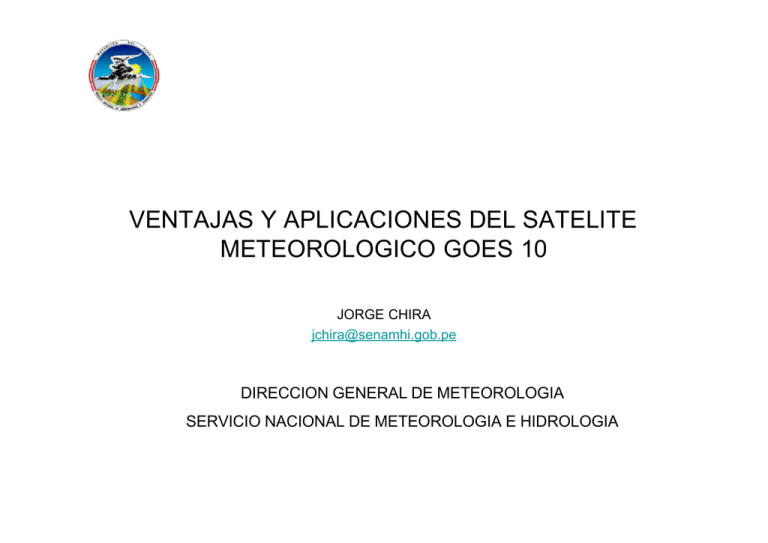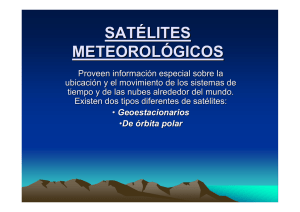VENTAJAS Y APLICACIONES DEL SATELITE METEOROLOGICO
Anuncio

VENTAJAS Y APLICACIONES DEL SATELITE METEOROLOGICO GOES 10 JORGE CHIRA [email protected] DIRECCION GENERAL DE METEOROLOGIA SERVICIO NACIONAL DE METEOROLOGIA E HIDROLOGIA INDICE • • EL SATELITE METEOROLOGICO GOES ACTIVIDADES ESPACIALES GOES – UBICACIÓN DEL SATELITE GOES 10 • DIFERENCIAS ENTRE EL SATELITE GOES 10 Y GOES 12 – CANALES DEL GOES 12 – CANALES DEL GOES 10 (SOUNDER E IMAGER) • ANIMACION GOES 10 IMAGER • COBERTURA DEL GOES SOUNDER • • • FUENTES DE DATOS GOES 10 OTROS POSIBLES PRODUCTOS DEL GOES 10 CONCLUSION EL SATELITE METEOROLOGICO GOES El Satélite Geoestacionario Operacional Ambiental (Geostationary Operational Environmental Satellite, GOES), es una de las claves del programa estadounidense del National Weather Service "NWS" de la NOAA. Los datos de imágenes y de sonda del GOES son continuos y proveen una corriente de información ambiental para apoyar el pronóstico del tiempo, el seguimiento de tormentas severas, y para investigación en meteorología Actividades Espaciales GOES Subsatellite Point Equator GOES-11 135° West GOES-10 60° West 36,000 Km G O E S • 1 3 GOES-12 75° West GOES-13 105° West (Spare) GOES-10 (Lanzado el 25 de Abril, 1997) – Movido a 60º W en apoyo al programa Earth Observation Partnership of the Americas (EOPA) : 2 de Diciembre, 2006 • GOES-11 (Lanzado el 3 de Mayo, 2000) – Reemplaza al GOES-10 que enfocaba al Asia y USA – Convertido a GOES-West el 21de Junio 2006 • • GOES-12 (Lanzado el 23 de Julio de 2001). Continua operaciones (desde 1 Abril de 2003). GOES-13 – Lanzado el 24 de Mayo de 2006! UBICACIÓN DEL SATELITE GOES 1O E IMAGEN DEL GOES 13 DIFERENCIAS ENTRE EL SATELITE GOES 10 Y GOES 12 GOES 10 • • • • • • • IMÁGENES CADA 15 MINUTOS SENSOR DE SONDAJE MAYOR NUMERO DE APLICACIONES PARA PRONOSTICO SATELITE ANTIGUO INCLINACION (corregida por NOAA) REQUIERE ANTENA ($10,000$20,000) O ADAPTACION APOYO DE NOAA PARA USO DEL SATELITE GOES 12 • • • • • IMÁGENES CADA MEDIA HORA NO TIENE SENSOR DE SONDAJE MENOR NUMERO DE APLICACIONES DE PRONOSTICO SATELITE MAS NUEVO NO SE TIENE APOYO PARA SU UTILIZACION CANALES DEL SATELITE GOES 12 CANAL 1- VISIBLE CANAL 3- VAPOR DE AGUA CANAL 1- VISIBLE CANAL 4- IR4 CANAL 2- IR2 CANAL 5- IR5 CANALES DEL GOES-10 Imager Datos de SSEC Data Center GOES-10 Imager – Cobertura (animacion) Mas informacion en: http://cimss.ssec.wisc.edu/goes/blog/2006/12/21/goes-10-southern-hemisphere-coverage Datos de SSEC Data Center CANALES DEL GOES-10 Sounder Datos de SSEC Data Center GOES-10 Sounder – Cobertura (animacion) Mas informacion en: http://cimss.ssec.wisc.edu/goes/blog/2006/12/21/goes-10-southern-hemisphere-coverage Datos de SSEC Data Center ALGUNOS CANALES DEL GOES-10 Sounder Band Wavelength Principal Num (um) Gas ber Sounding Purpose 3 14.1 CO2 upper-level temperature 5 13.4 CO2 lower-level temperature 8 11.0 window surface/cloud top temperature 10 7.5 H2O lower-level moisture 11 7.0 H2O midlevel moisture 12 6.5 H2O upper-level moisture 15 4.45 CO2 upper-level temperature 17 4.0 window surface temperature ARGENTINA COMISION NACIONAL DE ACTIVIDADES ESPACIALES http://ggt.conae.gov.ar/goes_sud/ BRASIL CENTRO DE PREVISION DEL TIEMPO Y ESTUDIOS CLIMATICOS http://satelite.cptec.inpe.br/home/# USA Cooperative Institute for Meteorological Satellite Studies http://cimss.ssec.wisc.edu/goes/rt/goes10.php APLICACIONES DEL GOES 10 APLICACIONES DEL GOES 10 TOTAL DE AGUA PRECIPITABLE APLICACIONES DEL GOES 10 PRESION EN EL TOPE DE LA NUBE OTROS POSIBLES PRODUCTOS DE GOES IMAGER AND SOUNDER GOES IMAGER o Atmospheric Motion Vectors (AMVs) o Quantitative Precipitation Estimates o Clear Sky Radiances o Sea Surface Temperature o Fire Detection Characteristics o Volcanic Ash o Fog o Cloud Parameters GOES SOUNDER o Clear Sky Radiances o Temperature and Moisture Profiles o Total Precipitable Water (TPW) o Atmospheric Stability Indices o Convection Available Potential Energy (CAPE) o Limited Index (LI) o Cloud-top Properties o Clear-sky Water Vapor Winds Via Radiance Tracking o Total Column Ozone (experimental) CONCLUSIONES • • • • El satélite GOES 10 tiene mayores aplicaciones para pronostico e investigación de las que actualmente vienen siendo utilizadas con el GOES 12 (actualmente utilizado en SENAMHI). Se requiere cierta inversión para adquirir nueva antena, sin embargo la NOAA (USA) y personal del CPTEC (Brasil) pueden apoyar la adaptación de la antena actual. El satélite GOES 10 tiene un periodo de vida menor pero puede ayudar en gran medida al pronostico. Existe un grupo ad-doc fomentado por la NOAA para apoyar la utilización del satélite GOES 10. ¡MUCHAS GRACIAS!

